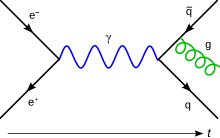
Second quantization, also referred to as occupation number representation, is a formalism used to describe and analyze quantum many-body systems. In quantum field theory, it is known as canonical quantization, in which the fields (typically as the wave functions of matter) are thought of as field operators, in a manner similar to how the physical quantities (position, momentum, etc.) are thought of as operators in first quantization. The key ideas of this method were introduced in 1927 by Paul Dirac, and were developed, most notably, by Vladimir Fock and Pascual Jordan later.
In this approach,...